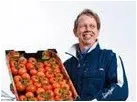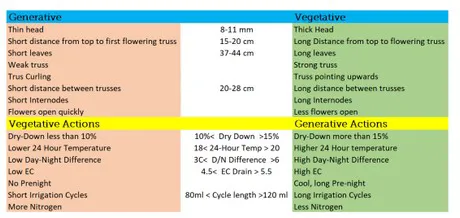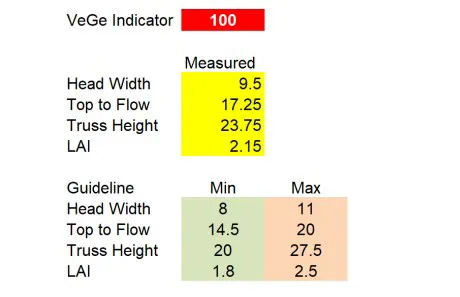 Vegetative and generative steering are widely used terms, but what is it? Godfrey Dol, an expert on cultivation in semi-closed glasshouses, wants to explain it in relation to cultivating in semi-closed greenhouses.
Vegetative and generative steering are widely used terms, but what is it? Godfrey Dol, an expert on cultivation in semi-closed glasshouses, wants to explain it in relation to cultivating in semi-closed greenhouses.
Tomato plants have survived in the wild for thousands of years. Like other fruiting plants or tree species, they have adapted to climate conditions by first building an assimilate factory through growing leaves. Once the plant has enough leaves, there is enough photosynthesis taking place to produce fruit, which is expensive in terms of assimilate distribution. The fruits eventually fell off the vine or were eaten by animals, who spread the seed and ensured the survival of the species.
Weather conditions affect the hormonal system of the plant and adversity (e.g. cool nights, drought) will trigger a shift from vegetative to generative growth. A grower can make use of this natural phenomenon to subtly change the climate, light, and irrigation strategy to help the plant generate the right impulses at the right time to reach its maximum potential yield.

Indicators
In principle, there are two conditions of plant growth, Godfrey continues. If a plant is converting too much of its photo synthetic quota to leaves (vegetation) growers/crop advisor will want to influence the plant growth with generative impulses. If the plant has a big fruit load, they will want to make sure that plants have enough vegetation to sustain such fruit load and enforce vegetative actions onto the plant.
Vegetative plants distinguish themselves from generative plants in many ways. Figure 1 tables the various characteristics given to vegetative and generative tomato plants. While this seems simple enough to recognize, any grower remembers the time when they first learned this and how confused they were about it.
Underneath the generative characteristics, the table lists typical vegetative actions a grower can take to balance the plants (and vice versa). A plant that is too vegetative will put too many assimilates into leaves and less in fruit. On an annual basis, this can result in 20% less production.
A generative plant puts more of its energy into fruit. This can overload the plant which results in high production for some weeks but then it drops off quickly. Similar yield losses will occur over a year.
Hence the importance of a good grower. Growers can instantly recognize a generative or vegetative plant and use tools such as plant registration to notice and confirm subtle changes to the plant they see.  Figure 1; Generative and Vegetative characteristics and pointers on how to negate the extremes
Figure 1; Generative and Vegetative characteristics and pointers on how to negate the extremes
The information in figure 1 is basic knowledge for professional growers, according to Godfrey. What is less well known is that when a plant grows in high light and low humidity environment, it responds to this generative action with vegetative growth. There is an immediate generative consequence to the action but in the long-term, this generative action stimulates vegetative growth because the plant is trying to adapt to the new environment by creating bigger leaves.
Similarly, lowering the 24-hour temperature will have an immediate vegetative impact, but if the period of low 24-hour temperatures is extended, the fruit will stay longer on the plant and become larger, putting more strain on the plant. More assimilates translocate to the fruit, so this vegetative action has long term generative consequences.
It is the balance between generative and vegetative growth that is important. Recognizing these trends early is essential because once a plant is too extreme on either side, the plant has changed its hormonal system and it is difficult to change back.
In this respect, a plant is a bit like a large container ship. If it goes off course by a fraction, there must be an immediate reaction otherwise it is difficult to get the ship back on course. If by the time harvesting begins, the plant is either too vegetative or too generative, the grower will battle the crop for the rest of its life.
If the crop is well balanced, it needs only small corrections for the rest of the crop. Hence it is important to get the plants on the rails in the first 3 months.
VeGe Indicator
To help determine if a tomato crop is generative or vegetative, Godfrey has developed a VeGe Indicator (see figure 2). It serves as a tool to help growers determine if their visual observation is congruent with more objective measurements. It considers head width, distance from the top of the plant to the first flowering truss, the distance from the first flowering truss to the next truss underneath and the Leaf Area Index (LAI).
The head width is recorded in mm, all other measurements are in cm. Enter the actual measured values from crop registration in the yellow cells. Underneath it is the guideline for each measurement. Growers can change the guidelines, for instance, the head width for a snacking tomato crop can be 7-9 mm instead of 8-11 mm.
The calculated value in the red cell is the VeGe Indicator. A value above 100 means the plant is vegetative, below 100 the plant is generative. A copy of this calculator can be downloaded from Godfrey's website.
The calculations show for instance, that if the VeGe Indicator is too vegetative (score is too high), the action of more de-leafing results in lowering the score (generative action). 
Figure 2; VeGe Indicator calculator.
The Semi-Closed Glasshouse
Are things any different in a semi-closed glasshouse when it comes to vegetative and generative steering? Yes and no, says Godfrey. How to create vegetative or generative actions does not change.
What is different is that the continuous air movement creates a constant vegetative impulse. The leaves are encouraged to transpire all the time! The plant will make larger leaves and will direct its sugars there, instead of to the fruit.
Growing in a semi-closed glasshouse is growing in a vegetative environment. Add to that that the fact that most semi-closed glasshouses are in warmer climates with high sunlight, one can understand why the plant only wants to make leaves.
So how to fix this? Godfrey has already talked about reducing fan speed in previous posts, but there are many other tools. Godfrey will discuss in future posts.
This article is part of a series about growing in a semi-closed greenhouse. Read here more about no-go's for semi-closed glasshouses, cooling, the difference between semi-closed and pad and fan glasshouses and how to prevent momentum, becoming a crop to vegetative and humidity, for example in tomato. The last updates in the series were about a higher humidity at night and CO2 increases and the effect on crops.
For more information:
Glasshouse Consultancy
www.glasshouse-consultancy.com
Godfrey Dol
LinkedIn
[email protected]
+81 80 700 94 006
